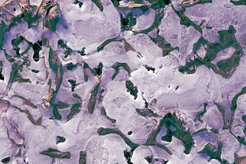Ice skating and permafrost
Investigation of thin liquid films at interfaces between ice and clay materials
From ice skating, it has been known for a long time that a thin liquid film forms on ice surfaces. This, along with other causes, is responsible for ice slipperiness. Scientists at the Max Planck Institute for Polymer Research have now investigated a related effect at interfaces between ice and porous clay minerals. Such interfaces are found in nature for example in permafrost. The results may help to better understand changes in frozen soils as temperatures rise.

For ice, so-called surface melting was postulated as early as the 19th century by Michael Faraday: Already below the actual melting point, i.e. zero degree centigrade, a thin liquid film forms on the free surface because oft he interface between ice and air. Scientists led by Markus Mezger, group leader at the Max Planck Institute for Polymer Research and professor at the University of Vienna, have now studied this phenomenon in more detail at interfaces between ice and clay minerals.
In nature, this effect is particularly interesting in permafrost soils - i.e. soils that are permanently frozen. About a quarter of the land area in the northern hemisphere is covered by permafrost. These are composed of a mixture of ice and other materials. Microscopically thin platelets were formed over geological time by the weathering of clay minerals. Similar to a sponge, a lot of water can enter the narrow slit pores between the thin platelets, be stored there, and freeze. Therefore, there is a lot of contact area between ice and clay minerals. For every gram of clay mineral, there are about ten square meters of surface area! This causes a comparatively high proportion of liquid water in the interfacially induced melt layer already below zero degree centigrade.
The researchers have now investigated how fast the water molecules move in the thin melt layer at the boundary between ice and clay mineral. This value, known as self-diffusion, is directly linked to the viscosity of the water. For three different minerals, it has been shown that the viscosity of water in the interface-induced melt layer is sometimes significantly higher than that of ordinary water - i.e., the molecules are limited in their ability to move because the layer is more viscous. These results may help to better understand various phenomena in the future, such as the mechanical stability of permafrost, the transport of plant nutrients and pollutants, and geochemical reactions such as ion exchange processes at ice/mineral interfaces.
For their measurements, the Mainz scientists collaborated with partners at the research reactors of the TU Munich and the Institut Laue-Langevin in Grenoble, France. The neutrons generated in the reactors there strike the sample at a certain speed. Similar to a ball bouncing back from a vehicle moving toward it at a higher speed, velocity measurements of the neutrons scattered from the sample allow conclusions to be drawn about the motion of the water molecules in the interface-induced premelting layer.












